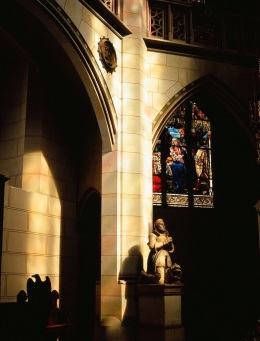Recently, I have been reflecting on what makes a good learning experience. Is it strong content and a teacher’s command of a subject’s knowledge? Or is it a deep
understanding of the different ways individuals process information and learn? Is there something about a teacher and their unique personality that fosters a positive environment for learning? And as a Christian educator, we are concerned about an individual’s formation. What about the movement of the Holy Spirit and its role in learning?
I must admit that I often yearn to make teaching a science. I desire to have all the right ingredients – strong content, a deep understanding of the learner, good leadership skills – and mix them all together where the result is an outstanding learning experience for all. While there is some truth in this analogy, teaching can also be described as an art where a teacher understands the unique climate of the context, asks thoughtful questions and creates exceptional conditions for deep learning. So which one is it? Is teaching an art or a science?
 Several years ago, I had the opportunity to visit a stunningly beautiful cathedral. From the light seeping through the stained glass to the smells of incense, from the stone arches that created lofty, high ceilings, to the unique examples of sacred art, it was amazing. The feelings that overtook me from standing small in such a magnificent example of architecture is one I can still feel inside of me. As my family explored the church, I sat and met God there. It was profound. It was holy. It was a sacred experience that impacted my soul.
Several years ago, I had the opportunity to visit a stunningly beautiful cathedral. From the light seeping through the stained glass to the smells of incense, from the stone arches that created lofty, high ceilings, to the unique examples of sacred art, it was amazing. The feelings that overtook me from standing small in such a magnificent example of architecture is one I can still feel inside of me. As my family explored the church, I sat and met God there. It was profound. It was holy. It was a sacred experience that impacted my soul.
Unbeknownst to me, there was also a lot of science going on in that building. There was a massive foundation (which I never saw) beneath my feet so that the ceiling could soar to the heights it did. There was planning and science in the structure, in the layout, and even in the art. But when I was there, I didn’t think about the science of a building. Even though it significantly informed my experience, it was not what I reflected upon.
I think the same can be said about formation and teaching. In the classroom, we experience people, emotions, conversations, information, and the Holy Spirit’s interaction with us and through us. But underneath all of this is an understanding of the development of human beings, a philosophy of how we learn, and research in teaching techniques. All of these things should inform my interaction and relationship with my students. I just don’t focus on it all the time. But it is there – just like the foundation of a building.
I believe teaching is both art and science (and a whole lot more, but that’s for another post!). The art and science of teaching are important. They need each other. They inform each other. It is not one or the other. It is a “both-and.”
What do you think teaching is? Are there other ways to look at the art and science of teaching?
